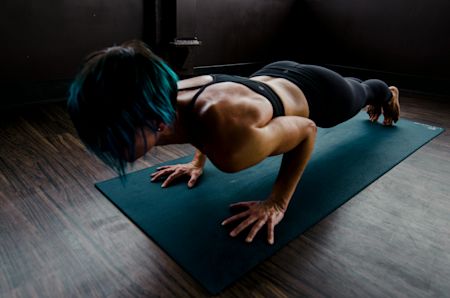“I’m in the best shape I’ve ever been at 45 – here’s how”
“This app has genuinely changed my life,” says Jill, 45, who joined The Body Coach in January 2025.
Get an annual subscription to The Body Coach app for just £69.99 (usually £89.99)

When you think of strength training, you’re probably picturing heavy barbells, a kettlebell, or some sort of equipment during a workout. But did you know you can build strength, sculpt your body, and boost your fitness – without any equipment at all?
You can – and it’s a great place to start.
Put simply, to strength train all you need is to create some resistance so your muscles are working that little bit harder than usual. And you can do this all with bodyweight.
The reason we often speak about strength training is because it has so many benefits for your mind and body – most notably it has been shown to increase bone density, improve your metabolic health, protect your joints, reduce body fat and support mental wellbeing.
We spoke to Richard Blagrove, a senior lecturer who researches strength and conditioning, and is a Programme Director of BSc Strength and Conditioning Science at a university. “It’s fair to say many people perceive strength training with lifting weights, and many associate it with body building, or with a focus on males,” says Richard.
So, what does “strength” training without weights actually look like?
Ultimately, strength training means each rep you do will be of a higher intensity. This means you would do less reps at a higher intensity in order to get the benefits. “The muscular force needs to be intense to get that meaningful strength adaptation,” says Richard, “so you’re looking for around 15 repetitions within 30 seconds, as research has shown that, when done correctly, it’s around 15 reps where we get the benefits.”
Through his research, Richard and his team have come up with bodyweight-only movements that allow you to strengthen and train muscles all over the body. If you do all the below – with 2-3 sets of 10 of each of those, “it’s a thorough and well-rounded approach to strength training,” says Richard.
1. Simple bodyweight squat Squats get your quads fired up – as you lower into the squat, your quad muscles engage to control you lowering yourself, then help power the upwards movement, too. You’re also targeting your glutes, hamstrings (which help stabilise your knees), and calves to build strength. As your muscles grow stronger, you can increase the challenge by adding more reps, or progressing to single-leg variations like pistol squats or a zombie squat with your arms out straight, says Richard.
2. Glute bridge Here, you’re activating your glutes as you lift your hips off the ground, as well as engaging your core muscles to maintain stability during the move. “You could also try a single leg glute bridge to up the intensity,” adds Richard.
3. Split squat lunge A split squat lunge is like an exaggerated step forward, where you drop your hips down to the ground and then come up again. Your front leg’s quads will be on fire as they’ll be heavily activated during this, especially as you lower and push back up again.
But you’re also working your glutes to stabilise the movement, and calves to stabilise your ankle and joints for balance.
4. Wall press-up A wall press-up is really focusing on strengthening your chest muscles, particularly as you push your body away from the wall. You’re also activating your triceps when you extend the elbows, as well as your deltoids (in your shoulder) helping to lift and extend the arm. On top of that your abs and lower back muscles will be engaged and strengthened to help your positioning.
You could start with a press-up against the wall, and progress to a press-up on your knees and then a full-press up – which is around 70% of your body mass.
5. Side planks Here, you’re working your core. In a side plank, you’ll be strengthening your obliques on the side of the torso, as well as your glutes, shoulders and core in order to stabilise yourself and prevent your body from dropping out of the position. The great thing about side planks is that they engage multiple muscle groups in your body simultaneously in one move.
It’s worth noting that for upper body exercises to strength train, you need a “pull and a push,” says Richard. For a pulling exercise, if you’re at home you need something to pull against in order to create resistance. Use a door frame! You could pivot your feet against a skirting board, grab hold of the door frame and pull yourself towards it.
Progressing your training
For all of the above, you don’t need any kit. And if you’re new to strength training, bodyweight really can provide what you need to build it up in the early days.
As you progress, you may need to up the intensity in order to get stronger, once your body has adapted. “The evidence is overwhelming,” says Richard, “we need the intensity to get stronger."
You might want to focus on getting resistance bands afterwards to add that resistance, before moving onto dumbbells. But, adds Richard, “there is a long way to go with body mass before you start having to get weights and equipment.”
So, for someone who has never strength trained before, bodyweight is a great place to start.
This article was written by The Body Coach content team.